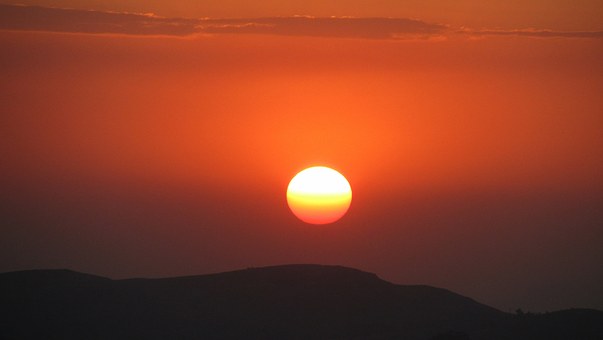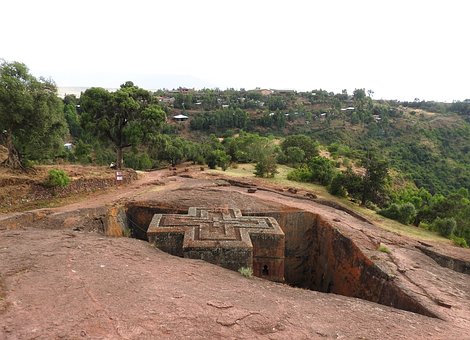Backpacking in Ethiopia
While travelling in Ethiopia you will come across a country on the Horn of Africa, where you will find a very rewarding and varied landscape and culture. Serengeti, savannah, desert, Sahel zone, fertile landscapes and dry zones, you will find all this here. A large part of the country lies on the roof of Africa at an altitude of 2000 metres. About 80 percent of the Nile water comes from the highlands with green mountain slopes and lush green meadows. The landscape of the Danakil depression in the north of the country stands in stark contrast to this.
The Ethiopian highlands are among the safest areas in Africa, so you won’t have to worry about theft and raids during your backpacker trip. If you take the usual security measures into account and use your common sense, this is quite sufficient. Problems can occur in the border area with Eritrea and Somalia, where military conflicts have occurred in the past. Since you are very unlikely to travel to problematic areas in particular, dangers are unlikely.
There is a good traffic infrastructure with relatively well-developed overland roads, where not only people but also animals are on the road. On your tour through the country you will come across unique, contrasting landscapes and relics from long ago, which belong to the World Heritage. You will find nine UNESCO World Heritage Sites, eight of which are World Heritage Sites and one World Natural Heritage Site. These include the rock churches of Lalibela and the Simien National Park.
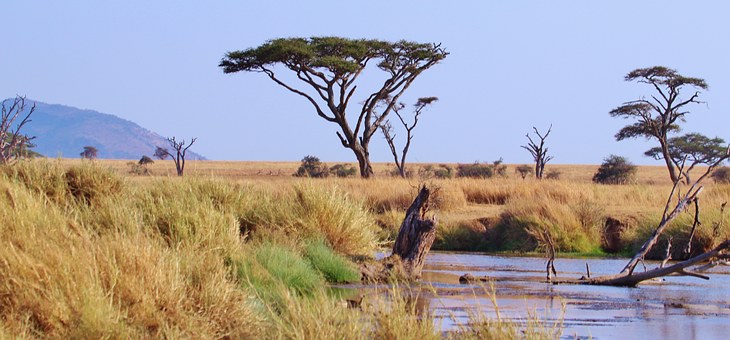
Unique nature in Ethiopia
The capital of Ethiopia is Addis Ababa, which translates as “New Flower”. In the language of the Oromo it carries the name Finfinne or Shaggar. Around 3.4 million people live here. The city is home to the UN Economic Commission for Africa and the headquarters of the African Union. Travelling in the country is very easy, both by land and by air, in order to get from A to B. Basically you can travel to Ethiopia all year round as the temperatures are quite stable all year round.
During your backpacking tour through Ethiopia you usually get money at ATM machines in the big cities. However, many normal EC cards are not accepted. With a credit card it works much better. For security you should always have enough cash with you. In addition to the local currency, the euro and the US dollar are equally accepted.
In the country the Amharic language is spoken predominantly, which is at the same time also the official language. This language is much too complicated to learn. But you don’t have to be prepared for communication problems. In the highlands you will meet locals with whom you can communicate at a reasonable level in English. This is not only the case in the tourist areas, but also in the countryside, where even the children have a good command of the English language.
You won’t starve in Ethiopia either. Because you can get the many African delicacies at food stands or other catering facilities that are right next to your location. You can eat just like the locals with your fingers.
Culture in Ethiopia
The Ethiopian culture is determined by the different religions. There are Muslims who practice the Sunni imprint, as well as Orthodox Christians and Protestants. Religion is a part of daily life, so that you come into contact with it again and again. Even if the practice of religions differs from your known forms, you will be amazed at how firmly the old popular belief and magical rites are anchored in Ethiopia.
The arts of sorcerers are in great demand when it comes to protecting the herd, the harvest and another enterprise, healing the sick as well as having luck in love and success in business. In rural areas you often come across rituals of the old popular belief. But also in the city people firmly believe in the practices and their success.
The Ethiopians are a very friendly and open people, so that you will be welcomed everywhere with great friendliness and great curiosity. You will also quickly feel the hospitality that is given to you.
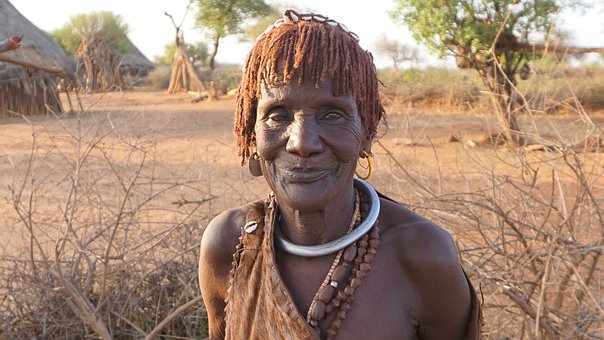
Natives in Ethiopia – Omo-Tal
More Backpacking Information about Ethiopia
Ethiopia is one of the cheapest travel countries in the world. So you can easily cover your daily budget as a backpacker with 20 to 30 Euro. However, if you want to see all the sights, you will have to plan a little more money for the different entrance fees.
In Ethiopia you can explore many interesting things and immerse yourself in the culture. You will encounter deserts, steppe landscapes and unique mountain landscapes with lush green meadows and fertile areas that contrast with other landscapes.
There are several ways to stay in Ethiopia. A simple double room can be found throughout the country from 10 euros a night. The average price in a hostel is around 15 euros.
For delicious delicacies of the African cuisine you rarely pay more than 5 Euros. You should try everything once, because real delicacies are waiting for you. During your backpacker tour you should get involved with the culture to see how different it is. The markets are a great place to shop. Besides fresh fruit, you’ll also get wonderful souvenirs like colorful fabrics, small, hand-carved African sculptures and typical African jewelry at unbeatable prices.
German citizens need a visa to enter Ethiopia. However, you have the choice of applying for a visa at the embassy or using a “Visa on Arrival”. What else you need to know as a backpacker can be found under Visa & Vaccinations.
Backpacker Budget in Ethiopia
Traveling and living in Ethiopia is quite cheap, unlike in other African countries. Usually you can expect to make ends meet with a budget of 20 to 30 Euro per day. But make sure that you don’t let commission sharks on the street fool you. If you want to see every sight, you should plan a higher daily budget, because sometimes additional costs arise. The currency in Ethiopia is the Ethiopian Birr.
Ethiopia’s economy has so far been dominated by agriculture. Despite high economic growth, it is one of the poorest countries in the world, which is also reflected in the purchasing power of the currency. You rarely pay more than 5 euros per person for a simple meal. In luxury restaurants and those that offer international cuisine, you pay more, but still not as much as at home. Outside the tourist areas you can already get enough for 1 to 2 euros.
Those who want to feed on Mc Donalds pay around 4 euros for a McMeal. Local beer in 0.5 litre bottles and imported beer in 0.33 litre bottles can be bought for 0.81 euros. Water is available for around 0.40 euros in 0.33 litre bottles. For a delicious cappuccino you pay around 0.70 euros.
The prices for the transport vary greatly and depend on which means of transport you choose for your backpacker trip. Therefore, you should take a closer look at the different travel costs before you start your trip.
Taxi driving Bus driving in Ethiopia
Traveling in local buses is the cheapest way to get from A to B. A simple one-way ticket for local transport is already available for 0.20 euros. If you stay longer in one place, a monthly ticket, which is already available for about 10 euros, is worth it. It is more expensive to take a taxi in Ethiopia. So you pay 1,60 Euro for a driven kilometre. As the taxis do not have a taximeter, you should negotiate a fixed price with the driver before starting the journey. The gasoline in Ethiopia is quite cheap with 0,75 Euro per litre.
Buses in Ethiopia
Buses are the main means of transportation and drive through the whole country. If you want to travel quite cheaply when backpacking, you should use the minibuses, which also take the locals. For one hour you pay between 0,50 and 1 Euro. Official buses often have a cheaper fare, but are much slower, so you’ll have to travel much longer. With a bit of luck, you can also find someone who’s just arriving at your desired destination with his 4WD and taking you with him for twice the price of the bus ticket.
True luxury is provided in the buses of SkyBus and Selam Bus. They travel several times a day to the big cities like Addis Ababa, Mekele, Aksum and other cities. You also get your own seat, which you don’t have to share with two other passengers.
Domestic fares in Ethiopia
Domestic flights are especially worthwhile if you have already entered the country with Ethiopian Airlines. There is a 50% discount on domestic flights for you. You can’t avoid the endless bus rides more cheaply and quickly. Important: These discounted flights are only available domestically. You simply go to an office of Ethiopian Airlines and present your boarding pass for your entry there. Without discounts, you pay between 50 and 100 euros for a domestic flight, depending on the route.
Rail travel in Ethiopia
There is only one railway line in Ethiopia which was built between 1894 and 1917 under French management. The line runs between Addis Ababa and Dire Dawa. However, there are no passenger trains here. The irregularly running train between Dire Dawa and Djibouti is not the ideal means of transport for your backpacker trip. In addition to the irregular trips, which are three times a month, the poor condition of the track represents a general safety risk.
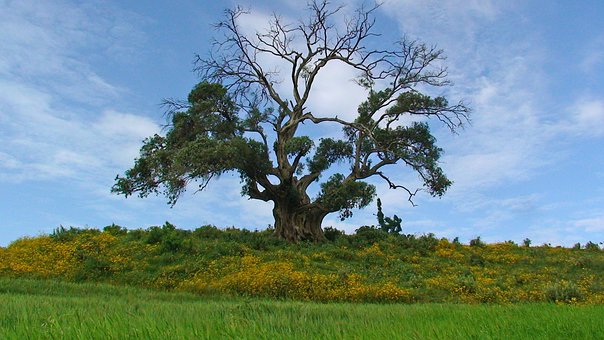
Green landscape in Ethiopia
Backpacker Routen in Ethiopia
A journey through Ethiopia gives you as a backpacker an indescribable variety of dreamlike landscapes that couldn’t be more different. The Serengeti and Savannah offer you endless expanses, where you’ll encounter a variety of animals that live in the wild. In the national parks you’ll find buffalos, giraffes, kudus, elenanthilopes, leopards, lions, hyenas, zebras, as well as aardvarks, baboons and crocodiles.
The highlands of Abyssinia in Ethiopia have quite rugged mountain formations in store for you. The mountains are between 2000 and 4533 meters high. The highest mountains rise majestically into the blue sky with their snow-capped peaks. The highest mountain is Ras Daschän with 4533 meters, followed by Buahit with 4510 meters and invites you to extensive hikes and trekking tours.
The blue Nile is fed with water from Lake Tana and its tributaries. In stark contrast to this are the dry zones where the desert spreads out and the Danakil depression. What shouldn’t you miss on your backpacking trip through Ethiopia?
Route 1: The classic (15-20 days)
- 2 days Addis Ababa explore the capital of the country and immerse into the culture.
- 2 days Dire Dawa. Also in this city there is a lot going on and a lot to visit.
- 3 days hiking in the Simien Mountains and roaming the Simien Mountains National Park.
- 2 days to discover a lot of tradition in Harar and Arab influenced architecture.
- 3 days to experience Yangundi Rassa National Park and Mile Serde Wildlife Reserve up close.
- 2 days in the rock churches around Lalibela to immerse yourself in the history of Christianity.
- 2 days Gonder. Discover the emperor’s palace, castles and Africa’s Camelot.
- 3 days combing the highlands and the unique landscape around Tana lake.
- 1 day Bahir Dar to admire the Blue Nile Waterfalls.
Route 2: Backpacker Intensive Trip (up to 30 days and more)
- 3 days Addis Ababa explore the capital of the country and immerse into the culture.
- 2 days Dire Dawa. Also in this city there is a lot going on and a lot to visit.
- 3 days hiking in the Simien Mountains and roaming the Simien Mountains National Park.
- 2 days to discover a lot of tradition in Harar and Arab influenced architecture.
- 3 days to experience Yangundi Rassa National Park and Mile Serde Wildlife Reserve up close.
- 2 days in the rock churches around Lalibela to immerse yourself in the history of Christianity.
- 3 days Gonder. Discover the imperial palace, castles and Africa’s Camelot.
- 3 days combing the highlands and the unique landscape around Lake Tana.
- 2 days in Bahir Dar to admire the Blue Nile Waterfalls.
- 2 days Nekemente, visit the former capital of Ethiopia.
- 3 days comb the Gambela National Park with its species-rich fauna and unique landscape.
- 3 days in the southern Omo valley to immerse into the culture of ethnic minorities.
- 2 days in Arba Minch to visit the forty springs and crocodile farm and observe hippos.
Travel times in Ethiopia
Basically you can visit Ethiopia all year round on a backpacker trip because the temperatures are stable all year round. The winter months between October and March are highly recommended. Less ideal are the summer months, as it rains more often. Heavy, short downpours are normal during this period and alternate with a few hours of sunshine a day.
But especially the rainy season offers you wonderful natural spectacles. You experience an incredibly green landscape and impressive waterfalls like the Nile waterfalls at Dahir Bar, which plunge into the depths with large amounts of water. Landscapes, which otherwise show a rather sparse vegetation, awaken to new life. As everywhere applies also in Ethiopia: There is no bad weather, only the wrong clothes.
Backpacker accommodation in Ethiopia
Ethiopia belongs to the cheap travel countries. This is also noticeable in the backpacking prices of the different accommodations, which you can use on your backpacker trip. So there are hotels in different categories. If you want to surround yourself with a little luxury, it will cost you a fortune. For a 5-star luxury hotel, it’s quickly 140 euros and more.
If you want to make your overnight stays quite inexpensive, look for a bed in a simple hostel. There are very few hostels in Ethiopia. You can find them on the Hostel pages Hostelworld and Hostelbookers. According to this, a bed in a hostel costs as follows:
- Addis Ababa 8-16 Euro
- Jinka 6 Euro
- Bahir Dar 7-12 Euro
- Lalibela 21 Euro
- Mekele 14 Euro
If you don’t prefer the hostels under 10 Euro a day, hotels and motels are guaranteed to be a good alternative because they offer a little more luxury. They come in different categories. Apart from the luxury hotels, however, this often does not necessarily meet the European standards.
Hotels and motels on exit roads and motorways
Hotels and motels in the cities, in the countryside and on exit roads are a pleasant overnight option. You will often be offered Bed & Breakfast. From about 11 Euro you get a comfortable double room, where you are guaranteed to feel comfortable and recover from the strains of the day.
Pensions in the countryside and in the cities
Beside a selection of hotels there are also very well maintained pensions for you, which you can use for an overnight stay. The next morning you will have a delicious breakfast with you. Such offers are between 7 and 20 Euro for one night.
A further option are holiday flats, holiday houses and privately rented rooms, which can be divided into different categories just like the hotels. In rural areas you will sometimes find less luxury, but in the middle of nature with a fantastic view that is not affordable with any money in the world. Luxury thus becomes a minor matter. For such accommodations you pay between 8 and 28 euros.
Backpacker Trips & Tipps in Ethiopia
When you travel through Ethiopia, there are endless opportunities for you to discover the country and immerse yourself in its culture. On the historical route in Northern Ethiopia you will come across all the important sights of the country, which you can explore relatively easily on your own. Another possibility takes you to the cultural north and wild south of Addis Ababa, through the Amhara region at Lake Tana to the mountainous Simien National Park, where you can visit the Highest Lodge.
At least as exciting and unique is a backpacker trip through the south of Ethiopia, where you will cross the Sanetti Plateau at an altitude of 4000 meters and follow in the footsteps of the Ethiopian wolf and Buspoli-Turaco. Again and again you will be impressed how different the landscapes are. You will encounter old African tribes and experience how the old cultures connect with the modern.
Backpacker Highlights in Ethiopia
A real backpacking highlight is the so-called “Historical Circuit”, where you will find four UNESCO world cultural heritage sites. Of course, this also includes the rock churches carved into the rocks. You roam the highlands and visit the Nile waterfalls. The different stations are Addis Ababa, Lalibela, Aksum, Simien Mountains, Gonder and Lake Tana, where unique sights await you.
Another highlight is the east of the country. A special highlight is the trade centre Harar. There is a dreamlike, Muslim influenced old town. You can also test your courage and feed the hyenas with the locals.
In the southern Omo Valley you will meet numerous ethnic minorities, so that you can immerse yourself deeply in the culture. Many different tribes live here. The best known are the Muris. From pictures you know this tribe, because these people are known by plates in the lower lip.
Backpacker insider tips in Ethiopia
If you’re on a two-day tour from Addis Ababa via Woldia, past Ashenge Lake to Makele, you’ll experience a canyon-rich, terraced, hilly landscape, crossed by serpentine roads. To the right and left of the road, you’ll find all the beauty of nature and an indescribable variety of directions that will reward you.
Mekele is a big city with a special flair. You will encounter a neighborly, small-town and friendly atmosphere. A special insider tip awaits you on your way to Wukro, where you will get an insight into the fascination of the rock churches Wukro Cherkos and Abuna Yemata. Abuna Yemata cannot be seen from the ground, as she is at least 100 metres above sea level. You will overcome this difference in altitude while climbing and need a rope to do so.
As a reward there are unique, wonderful wall paintings. Another insider tip on the border to Eritra is the Derbe Damo monastery, which is enthroned high up on a rock plateau. The ascent with the rope is worth it, because besides the visit of the monastery, the indescribable vastness of the landscape awaits you.
Essen & Trinken in Ethiopia
The continent is not exactly known for its great cuisine. So you’ll experience highlights as well as lows. But an exception in backpacking is Ethiopia’s cuisine, which has delicious dishes ready for you. Ethiopian food is super delicious, more or less spicy and very varied as well as extremely cheap.
It’s unbelievable fun to eat a plate of Injera with different curries together in a convivial group. Ethiopia is a paradise for vegetarians with around 200 days of fasting per year and firmly integrated fasting food, which is mainly available at Easter and during the Christmas season. It is predominantly eaten with the fingers of the right hand. Plates and cutlery replace the injera.
Food in Ethiopia
Ethiopia’s cuisine differs greatly from sub-Saharan Africa and the Oriental region. An important staple food is the special sourdough pita bread called Injera. It is normally made from the local cereal teff. However, other types of grain are also used.
There are different sauces, which are called Wot. They are available in different meaty and vegetarian versions. Who can afford it, eats meat in addition. Predominantly lamb meat comes on the plate. Pork is only available from Christians who are missionaries, as Islam and the Ethiopian Orthodox Church frown upon this meat and regard it as unclean.
Another delicacy is the Alitscha vegetable stew, which is prepared with different kinds of vegetables and eaten with the fingers and injera. In many cases the meals are spiced quite spicy with Berbere. A special delicacy are dishes with raw beef. In its purest form it is eaten as tere siga. However, there are also more upscale variants called Kitfo and Gored Gored.
Drinking in Ethiopia
Ethiopia is the home of coffee. Therefore it is not surprising that you reach the next coffee stand within 5 minutes during your backpacker trip. The coffee is freshly roasted and poured from a special jug called Jabana. There are also countless local types of beer.
A simpler, local type of beer is the millet beer Tella. In terms of taste, it is rather in need of getting used to for the European palate. Therefore, you are guaranteed to rather fall back on an export beer. Delicious are the many different kinds of wine, which you should taste just like the Tej honey wine.
Backpacker Visa und Impfungen in Ethiopia
For your backpacker trip through Ethiopia you need a visa, which you can get at the Ethiopian Embassy in Berlin, at the Consulate General in Frankfurt or at the airport of entry. Valid entry documents are also important. According to the Federal Foreign Office, the entry requirements are as follows:
- Passport: Yes
- Provisional passport: Yes
- Identity card: No
- Temporary identity card: No
- Passport for children: Yes, with photograph
Annotations
On arrival and departure at Addis Ababa Bole International Airport, fingerprints will be taken at passport control as well as a digital passport photo of the arriving person. If you refuse to travel on your backpacker trip, you may be denied entry and exit.
Before entering the country, you should obtain legally binding information directly from the embassy or consulate general, as entry regulations may change at short notice. In addition, you should pay attention to the current information where you will be informed about crisis and other exceptional situations.
Medical Information & Vaccinations for Ethiopia
In the case of direct entry from Germany, no compulsory vaccinations are planned. However, it is advisable to have the standard vaccinations of the Robert Koch Institute up to date. These include diphtheria, pertussis, tetanus, and possibly polio, mumps, measles and rubella as well as influenza and pneumococcus.
Travel vaccinations such as hepatitis A and B, yellow fever, typhoid fever, rabies and Menningococcus are also recommended. In larger cities there is good medical care according to the country, but it does not necessarily meet European standards.

